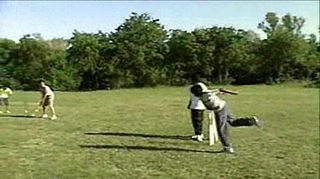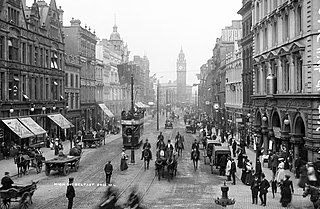Trespass is an area of tort law broadly divided into three groups: trespass to the person, trespass to chattels, and trespass to land.
Nuisance is a common law tort. It means something which causes offence, annoyance, trouble or injury. A nuisance can be either public or private. A public nuisance was defined by English scholar Sir James Fitzjames Stephen as,
"an act not warranted by law, or an omission to discharge a legal duty, which act or omission obstructs or causes inconvenience or damage to the public in the exercise of rights common to all Her Majesty's subjects".
In English criminal law, public nuisance is a act, condition or thing that is illegal because it interferes with the rights of the general public.

English tort law concerns the compensation for harm to people's rights to health and safety, a clean environment, property, their economic interests, or their reputations. A "tort" is a wrong in civil law, rather than criminal law, that usually requires a payment of money to make up for damage that is caused. Alongside contracts and unjust enrichment, tort law is usually seen as forming one of the three main pillars of the law of obligations.

Rylands v Fletcher (1868) LR 3 HL 330 is a leading decision by the House of Lords which established a new area of English tort law. It established the rule that one's non-natural use of their land, which leads to another's land being damaged as a result of dangerous things emanating from the land, is strictly liable.

Trespass to land is a common law tort or crime that is committed when an individual or the object of an individual intentionally enters the land of another without a lawful excuse. Trespass to land is actionable per se. Thus, the party whose land is entered upon may sue even if no actual harm is done. In some jurisdictions, this rule may also apply to entry upon public land having restricted access. A court may order payment of damages or an injunction to remedy the tort.
Tortious interference, also known as intentional interference with contractual relations, in the common law of torts, occurs when one person intentionally damages someone else's contractual or business relationships with a third party, causing economic harm. As an example, someone could use blackmail to induce a contractor into breaking a contract; they could threaten a supplier to prevent them from supplying goods or services to another party; or they could obstruct someone's ability to honor a contract with a client by deliberately refusing to deliver necessary goods.

Canadian tort law is composed of two parallel systems: a common law framework outside Québec and a civil law framework within Québec. Outside Québec, Canadian tort law originally derives from that of England and Wales but has developed distinctly since Canadian Confederation in 1867 and has been influenced by jurisprudence in other common law jurisdictions. Meanwhile, while private law as a whole in Québec was originally derived from that which existed in France at the time of Québec's annexation into the British Empire, it was overhauled and codified first in the Civil Code of Lower Canada and later in the current Civil Code of Quebec, which codifies most elements of tort law as part of its provisions on the broader law of obligations. As most aspects of tort law in Canada are the subject of provincial jurisdiction under the Canadian Constitution, tort law varies even between the country's common law provinces and territories.

Miller v Jackson [1977] QB 966 is a famous Court of Appeal of England and Wales case in the torts of negligence and nuisance. The court considered whether the defendant - the chairman of a local cricket club, on behalf of its members - was liable in nuisance or negligence when cricket balls were hit over the boundary and onto the property of their neighbours, Mr and Mrs Miller, the plaintiffs.

Sturges v Bridgman (1879) LR 11 Ch D 852 is a landmark case in nuisance decided by the Court of Appeal of England and Wales. It decides that what constitutes reasonable use of one's property depends on the character of the locality and that it is no defence that the plaintiff "came to the nuisance".
Allen v Flood [1898] AC 1 is a leading case in English tort law and UK labour law on intentionally inflicted economic loss.

Quinn v Leathem [1901] UKHL 2, is a case on economic tort and is an important case historically for British labour law. It concerns the tort of "conspiracy to injure". The case was a significant departure from previous practices, and was reversed by the Trade Disputes Act 1906. However, the issue of secondary action was later restricted from the Employment Act 1980, and now the Trade Union and Labour Relations (Consolidation) Act 1992. The case was heavily controversial at the time, and generated a large amount of academic discussion, notably by Wesley Newcomb Hohfeld, which continued long after it was overturned.
The following outline is provided as an overview of and introduction to tort law in common law jurisdictions:
Economic torts in English law refer to a species of civil wrong which protects the economic wealth that a person will gain in the ordinary course of business. Proving compensation for pure economic loss, examples of an economic tort include interference with economic or business relationships.
Nuisance in English law is an area of tort law broadly divided into two torts; private nuisance, where the actions of the defendant are "causing a substantial and unreasonable interference with a [claimant]'s land or his/her use or enjoyment of that land", and public nuisance, where the defendant's actions "materially affects the reasonable comfort and convenience of life of a class of Her Majesty's subjects"; public nuisance is also a crime. Both torts have been present from the time of Henry III, being affected by a variety of philosophical shifts through the years which saw them become first looser and then far more stringent and less protecting of an individual's rights. Each tort requires the claimant to prove that the defendant's actions caused interference, which was unreasonable, and in some situations the intention of the defendant may also be taken into account. A significant difference is that private nuisance does not allow a claimant to claim for any personal injury suffered, while public nuisance does.
Trespass in English law is an area of tort law broadly divided into three groups: trespass to the person, trespass to goods, and trespass to land.

Cambridge Water Co Ltd v Eastern Counties Leather plc [1994] 1 All ER 53 is a case in English tort law that established the principle that claims under nuisance and Rylands v Fletcher must include a requirement that the damage be foreseeable; it also suggested that Rylands was a sub-set of nuisance rather than an independent tort, a debate eventually laid to rest in Transco plc v Stockport Metropolitan Borough Council.

Tort law in India is primarily governed by judicial precedent as in other common law jurisdictions, supplemented by statutes governing damages, civil procedure, and codifying common law torts. As in other common law jurisdictions, a tort is breach of a non-contractual duty which has caused damage to the plaintiff giving rise to a civil cause of action and for which remedy is available. If a remedy does not exist, a tort has not been committed since the rationale of tort law is to provide a remedy to the person who has been wronged.

Marcic v Thames Water plc [2003] UKHL 66 is a UK enterprise law and English tort law case, concerning water in the UK.

Watkins v Home Office and others[2006] UKHL 17, was a United Kingdom legal case heard by the House of Lords where the Home Office made an appeal as to whether the tort of misfeasance in public office was actionable in the absence of proof of pecuniary losses or injury of a mental or physical nature. The appeal was upheld, ruling that the tort of misfeasance in public office is never actionable without proof of material damage as defined by Lord Bingham of Cornhill.









